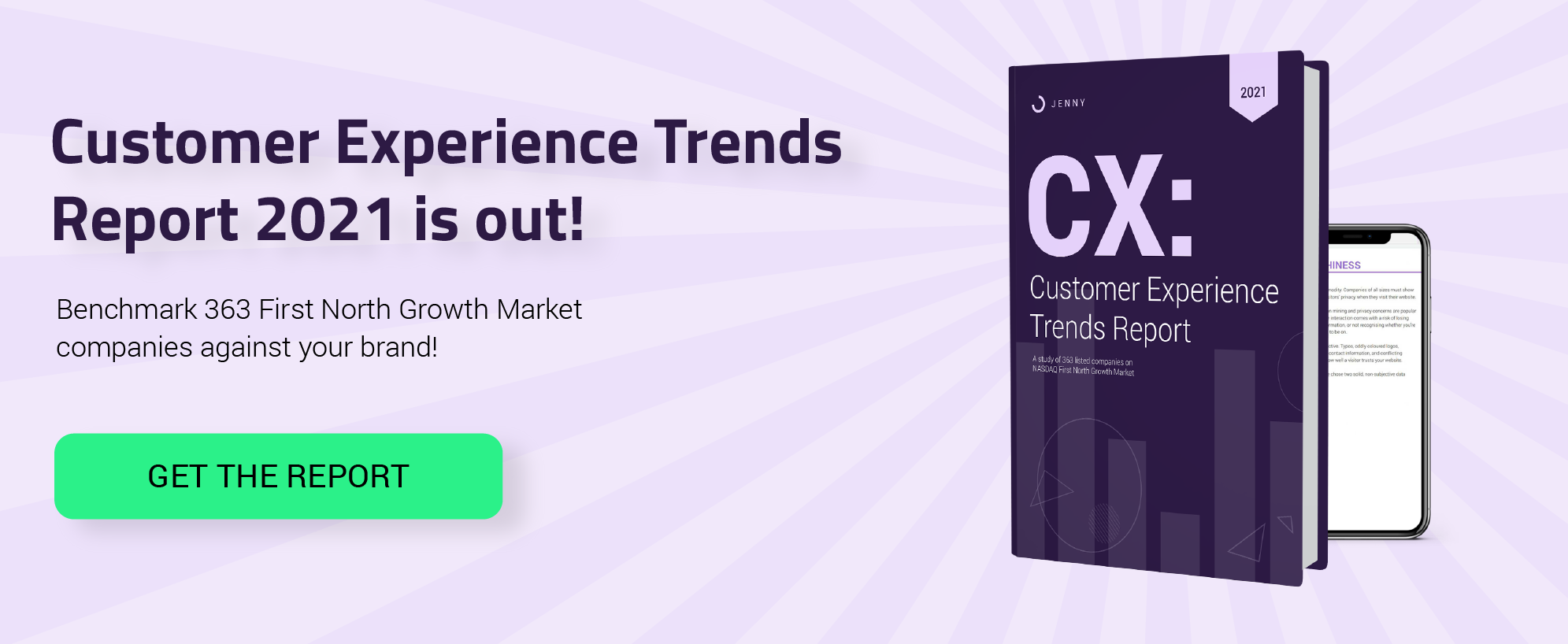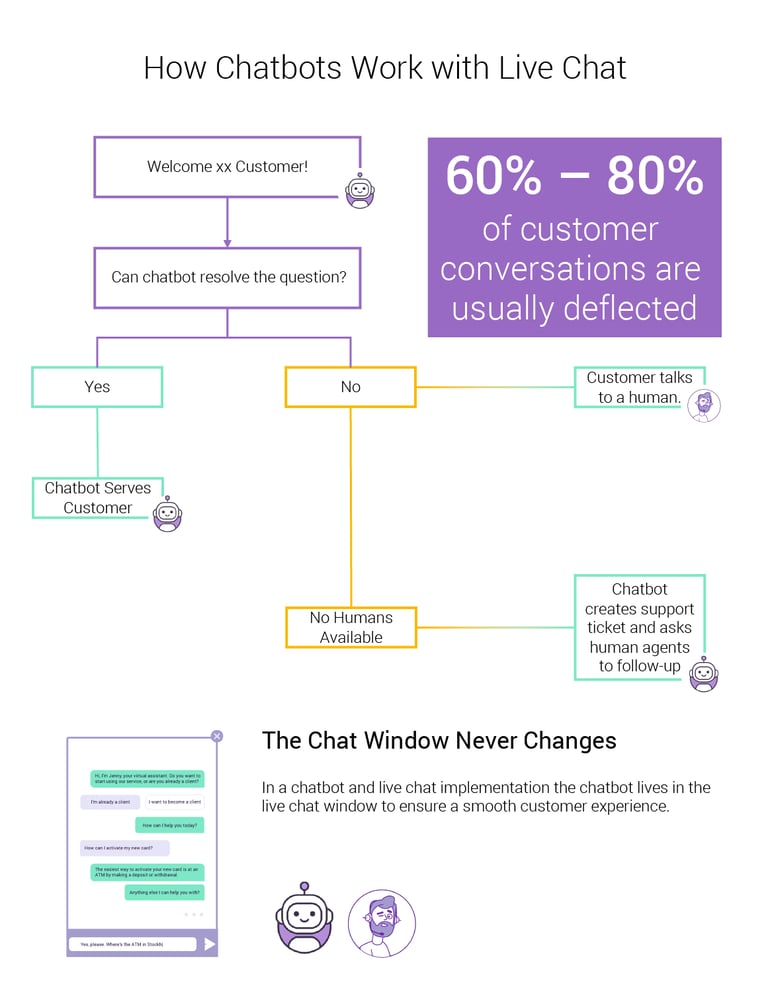- RESOURCES
- What is a chatbot?
What is a Chatbot?
A comprehensive guide to the different chatbots available on the market, how to choose the right one for your brand, and how to measure its success.
A comprehensive guide to the different chatbots available on the market, how to choose the right one for your brand, and how to measure its success.
What Is a Chatbot?
A computer program anybody can talk to with normal language.
No matter what type of chatbot it is, they all have a similar purpose -- to take regular human language input, understand what is being said and to provide a relevant, correct answer based on the knowledge it has.
Why Use Chatbots?
Chatbots excel at completing repetitive tasks and work around the clock. They can work alone or alongside humans, and are effective at completing 60-90% of an average human team's workload, depending on the use case.
What Chatbot Use Cases Are There?
GetJenny specializes in supporting brands who want to provide excellent CX by deflecting and automating customer service questions from customers.
But chatbots are not confined to increasing productivity in a customer service team.
They are also very effective at lead generation, as a conversational company wiki, for first-stage interviews in HR, and much more. We wrote an extensive guide to 25 Chatbot Use Cases to help you find the use case that matches your needs.
What Types of Chatbot Are Available?
There are two main types of chatbot. Button Bots and Conversational Chatbots.
Button Bots are based on predefined buttons and lead the user down a garden path with those button choices. You cannot talk to a button bot.
Conversational Chatbots understand user input. So a user should be able to type in a question and get a relevant answer from the chatbot. There are sub-types of Conversational Chatbot, which are covered more extensively in "How Do Chatbots Work". Conversational Chatbots can, and generally do, use buttons as a backup function.
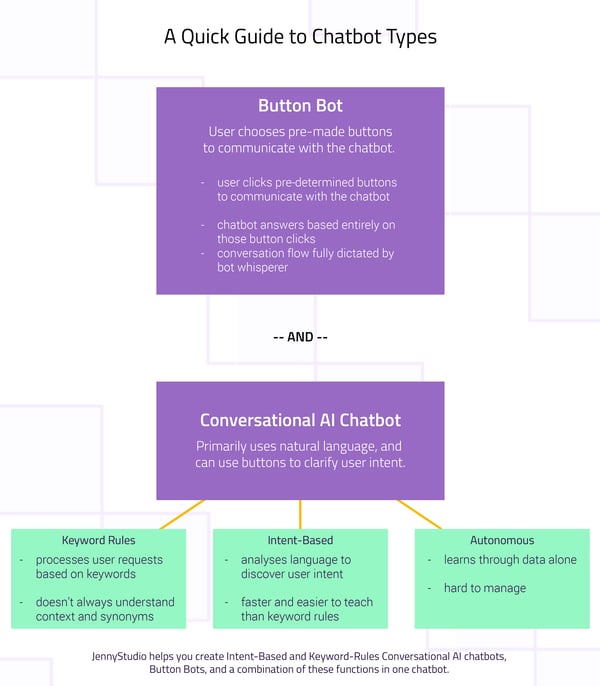
How Do Chatbots Work?
Under the categories of Conversational Chatbots and Button Bots, there are sub-variants of chatbot. Although how they work might change radically (and affect their overall quality), all chatbots have two basic high-level functions: "understanding" and "answering".
Familiarizing yourself with these two functions is generally the most important factor when choosing a chatbot for your brand, as they dictate how much human work is necessary to maintain a chatbot.
Understanding
A chatbot has to understand what you want. It can do this in four ways.
Button Bot
This is the most basic way a chatbot can understand intent. The chatbot builder puts buttons into the chatbot as question prompts for the user.
|
Pros |
Cons |
|
Language Independent |
No User Input |
|
Set Pathways |
Note: Button Bots can be incorporated as a feature in more advanced conversational AI chatbots. This useful feature can be used to confirm user intent at any time, when the AI is unsure or wants clarification.
Keyword Rule Chatbot
Keyword Rule Chatbots take typed questions from the user and generate a response based on whether they use a certain keyword or not.
Chatbots that use keyword recognition rules are technically AI Chatbots, as they use a simple form of Natural Language Processing (NLP).
|
Pros |
Cons |
|
Users can type in their questions and get a response immediately, they don't need to go through multiple clicks, like in button bots. |
Keyword Recognising Chatbots depend a lot on the NLP engine that runs them. If it can't recognise synonyms or compounds of keywords, then the user won't get their answers if the human chatbot builder hasn't considered these keywords for the chatbot. |
|
Chatbot Builders get user feedback in the form of "Unanswered Questions". This lets them improve the chatbot over time based on real user intent. |
Intent-Based AI Chatbot
This combines NLP and Natural Language Understanding (NLU) to figure out the intent in the user's question.
The difference between basic NLP and NLU can be shown in this example:
Basic NLP
George asks the chatbot, "Where is my car?", but the chatbot has only been taught to understand that question if the word "automobile" is used. So it cannot understand the question.
NLU
The chatbot has been taught the phrase, "Where is my automobile" and knows the answer to that. But George asks: "Where can I find my car?". Even though the Intent-Based AI chatbot hasn't been taught this phrase, it will see that George's intent is the same and still give the right answer.
|
Pros |
Cons |
|
The chatbot understands massive variations in language, because it matches intent. |
Clustering uses unbridled AI technology to recognise similar customer questions and group them together for question-answer pairs. Because of the nature of unbridled AI, it requires some quality control from human intelligence to weed out any glaring issues. As a result, clustering used primarily as a first step in chatbot building for companies with existing data on customer questions. |
|
Chatbot Builders get NLU-based suggestions to the "Unanswered Questions", so they can teach the chatbot to answer more questions more quickly and accurately. |
|
|
You can "cluster" pre-existing customer questions from live chat and rapidly create a first version intent-based chatbot. |
Autonomous AI Chatbots
This chatbot follows no rules, except for the ones it makes up for itself. This is the closest to the science-fiction AI most people imagine. It takes any information it can get from anywhere and creates questions and answers, based on its experience.
This is a baby in the field of AI, and publicly released versions of autonomous AI chatbot technology have been clear failures.
|
Pros |
Cons |
|
You don't need people to train it. |
You don't need people to train it, seriously Tay. 🙄 |
Answering
In order to answer a question, it must be paired with an answer. All chatbots function on question-answer pairs. How they match questions to those answers differs a lot.
Button Bot
With a button bot, the button "questions" you present to users are paired with specific answers. So your chatbot builder has prepared a very strict garden path for the user to follow, and there is no room for unexpected questions or wrong answers.
Intent-Based AI Chatbot and Keyword Rule Chatbot
We bulk these together because the principle is very similar, but the execution is somewhat different.
Both Intent-Based AI Chatbots and Keyword Rule Chatbots give users an answer based on the answer criteria. With both forms of chatbots, you can use negative keywords to rule out certain answers. For example:
Mary asks about credit cards on a banking website. If she asks, "Where can I get a credit card statement?", both types of chatbot should direct her to her credit card statement.
If she asks, "Where can I get a credit card?", this clearly has a different intent, so we use negative keywords to make sure she's directed to a credit card application, rather than getting a credit card statement.
For Intent-Based AI Chatbots, detecting this sort of intent is usually not difficult compared to a Keyword Rule Chatbot, but it's an extra failsafe to make sure the user gets the correct information, every time.
Autonomous AI Chatbots
This will try to create an answer based on previous experience and data. It's based entirely on what the AI thinks what the user intent is, with no failsafe like rule-based chatbots.
What Is Chatbot Automation and Deflection?
Automation and Deflection applies to most chatbot use cases, and calculating their benefits is quite similar across all use cases.
However, to provide a real-world example, without being too theoretical, let's focus on how to define and calculate customer service chatbot automation and deflection.
Customer service chatbots are designed to remove up to ~90% of a human customer service team's workload. They do this by solving customer questions through two actions, automation and deflection.
Deflection
A customer service metric that applies across different parts of the industry, but here we focus on the relationship between live chat and chatbots.
Deflection happens when a customer service team and their chatbot work during the same hours. The chatbot initiates every chat conversation with a customer and attempts to solve their question.
If successful, the chatbot has deflected that customer away from a human customer service representative or agent.
When the chatbot cannot answer the customer's question, it transfers the conversation over to the next available customer service representative or "agent".
How to Calculate Chatbot Deflection Rate
Deflection rate is calculated by taking the total number of chat conversations during customer service hours and dividing it into the number of conversations transferred to an agent, subtracting the result from one, and multiplying the figure by one hundred for a percentage of chatbot-deflected conversations.
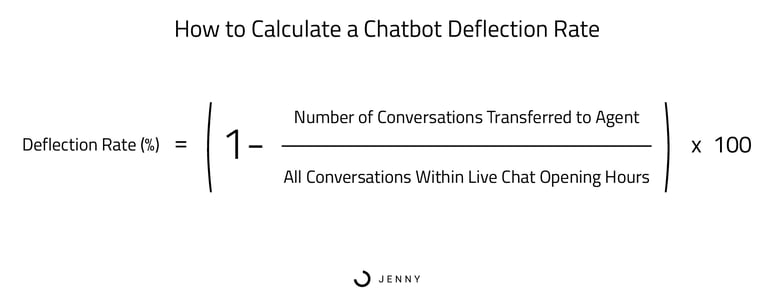
Automation
When the chatbot works without human agents as a backup, it automates conversations. This is often the case when the chatbot is providing customer service outside of office hours.
Customer service chatbots are taught to perform slightly differently outside of office hours. When it knows that there is no human agent back-up.
If the chatbot knows the answer to the question, then all is good. If it doesn't know the answer to the question, it will apologize to the customer and offer alternative options like:
- leaving their details for a callback
- pointing the customer to knowledge articles related to their question for assisted self-service
- opening a ticket in the service desk's ticketing system with details of the issue
- asking the customer to check back at a stated time when there is sure to be an agent online
How to Calculate Chatbot Automation Rate
There are two ways to calculate chatbot automation rate. One gives a general overview of chatbot performance, and the other is more granular, focusing only on conversations outside of human service hours.
General Automation Rate
Calculated by dividing all conversations the chatbot had into the conversations the chatbot was unable to resolve, subtracting the result from one and multiplying that figure by a hundred for a percentage of chatbot-automated conversations over a general time period.
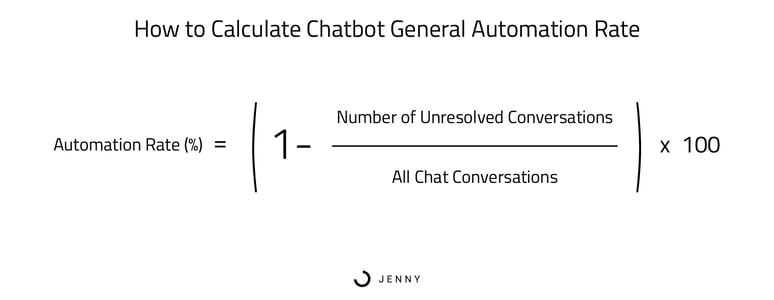
Outside of Service Hours Automation Rate
Divide all the conversations the chatbot had outside of live chat service hours into the unresolved conversations during the same time period, subtract that number from one, and multiply by one hundred for a percentage of chat conversations automated outside of service hours.
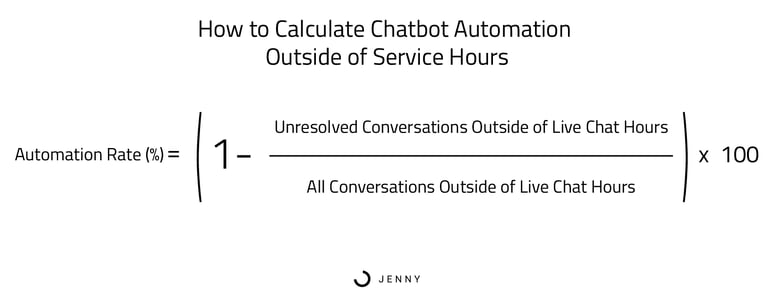
Message Automation and Deflection
A very granular way to analyze chatbot performance is to focus on each individual message and measure each individual success rate. This method uses similar formulas to the above, but uses answered and unanswered messages to calculate the percentage.
Whether to use messages or conversations as the metric depends a lot on your focus in customer experience. Conversation metrics are used more often because we want to look at the overall customer experience, and is a more valuable figure to compare against customer feedback at the end of every chat conversation.
Do I Need an AI Chatbot?
If you want to offer your users a conversational experience, you need an AI chatbot. Keyword Rule chatbots are the most basic type of AI chatbots, but intent-based chatbots are clearly a better option.
Intent-based chatbots take advantage of the adaptive power of artificial intelligence and machine learning which saves time in manual human labour.
We feel autonomous AI chatbots are not a good choice for brands. They still have a long way to go before brands should use them to represent their public image.
Are All Intent-Based Chatbots the Same?
No. The widespread chatbot market is relatively new, and a lot of terms are still being defined by various chatbot vendors.
Ultimately, most advanced AI chatbots aimed at medium and large brands are intent-based, but there are stark differences between the chatbot vendors. Here's what to look out for:
Can I Build and Maintain AI Chatbots Myself?
In the past, AI chatbots were traditionally built by coders and developers hired by consultants, because it required more technical skills to build the chatbot. Some vendors still operate this way.
But as the chatbot market grows, more vendors are recognising the need for subject matter experts to build and maintain the chatbot easily, instead of developers.
At GetJenny, we believe in a principle called Human-Directed AI. This stems from the idea that subject matter experts must be in charge of building the chatbot, because the chatbot is a tool for dispensing information, and information should be provided by these experts. Subject matter experts who build chatbots without needing to code are known as Bot Whisperers.
For a customer service use case, you would choose one or two of your customer service agents to be Bot Whisperers for your brand’s chatbot.
For Bot Whisperers to build and maintain an effective AI chatbot, you need an interface between the AI and the human building the chatbot. This interface must have a low learning curve and be easy-to-use.
This means Bot Whisperers can simply focus on pouring their expertise into the chatbot and not worry about learning coding or the intricacies of AI engineering. JennyBot is designed specifically for this purpose.
Keyword Rules or Intent-Based?
On their own, neither of these options are optimal.
Keyword Rule chatbots are very prescriptive and prone to error over the slightest oversight in chatbot building. This requires a lot of work and time to build a question-answer pair that takes into account all possibilities of a request.
Intent-Based chatbots are much faster and cheaper to build. They're better at discerning the question the user is asking, but could get confused by similarly constructed, but wildly different requests.
To get the best bang for your buck, it's much more efficient to primarily build an intent-based chatbot supported by keyword rules to avoid AI confusion. In the longer run, this will result in better overall deflection and automation rates, and requires less maintenance.
Language Models
Language models are how well a chatbot knows any particular language. They are built by compiling huge amounts of written data, feeding it to the AI, and examining how it learns and understands the language over time. This is a form of machine learning, which is a branch of AI.
The more data the AI learns, the more accurate it is likely to be, like when your teacher told you to read more books to broaden your vocabulary in high school. It's a similar principle.
English language models have seen the most development, simply because there is more public English language data available than any other. Google and Amazon both made great advances in English language modelling during the last few years.
Although the complexity of the language certainly plays a part, the less data available in any particular language, the more difficult it is to build a model for it.
For example, the Finnish language is complex because of its extensive use of compound words as well as altering words based on tense, pronouns, prepositions and whether it's an interrogative sentence. And this is with the "proper" Finnish language, as opposed to more casual language. But, since it’s a relatively small language, it doesn’t have the same amount of data to build a language model, like English does.
So look for a chatbot vendor who knows their language models and uses ones that work for your preferred languages.
How Do I Evaluate Chatbot Vendors?
Get a demo. Talk to their existing customers. Find out if they will deliver on their promises.
Would you like to know what kind of questions you should be asking chatbot vendors? Take a read through our in-depth guide: Must-Have AI Chatbot Features for Better Customer Experience.
Also, here’s a handy list of chatbot vendors who compete with GetJenny, feel free to compare us.
We have a team of chatbot experts on-hand to help you navigate chatbots - our job is to make sure you get a solution that fits your needs. All you have to do is book a meeting.
Note: this page was updated on 21 April 2021 to include a link to our new guide to AI chatbot features.


